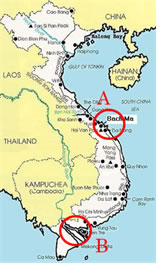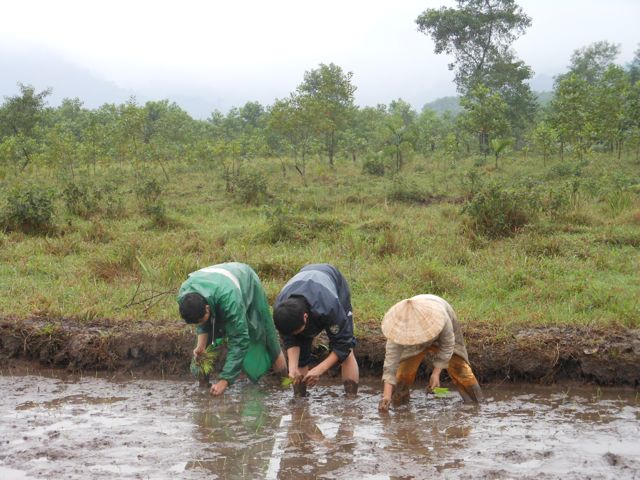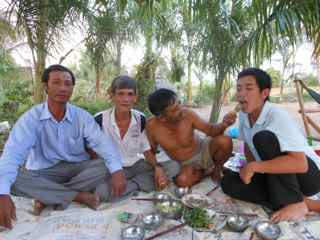活動報告
ベトナム・農工大JICA草の根技術協力事業(フエ大学・バックマー国立公園)/ 小規模(ベトナム中部)&大規模(メコンデルタ)稲作における農業資源削減方策
Host:Bach Ma National Park and Hue University of Agriculture and Forestry
Location:Bach Ma National Park
Duration:From 14 February to 13 May 2012
Key words: Farming Resources, SRI (System of Rice Intensification),
Kazuhiro AOI ![]()
International Environmental Agricultural Science Graduate School of Agriculture
 |
 |
 |
| Fig. 1 The location of targeted area in this internship
(A: Bach Ma national park, Hue University of Agriculture and Forestry, B: Can Tho University) |
Fig. 2 Transplanting with the farmers in SRI paddy field, Khe Su, Bach Ma national park | Fig. 3 Interview the famers in Mekong Delta (Mr. Trung, An, Sau and me from left side). |
1. Targeted/related environmental issues and their background
The targeted environmental issue in this internship was the “excess inputs to paddy field” such as sown rice seeds,
applied chemical fertilizer, sprayed pesticide and herbicide etc. It causes lots of environmental issues. For instance,
the excess application of nitrogen fertilizer causes the generation of methane, which is one of green house gases, while
highly drained pesticide to canal and river threaten lives of insects.
Since the introduction of “Green Revolution”, the rice cultivation with a combination of high inputs and the use of a
hybrid variety has been expanded to all over the Vietnam. It has been strongly pushed by the government forward international
competition in rice production and offered higher rice production to the famers. On the other hand, the use of chemicals for
paddy field has drastically increased, which is currently a serious issue to be immediately solved. In fact, the issue occurs
because the famers have less knowledge about the use of chemicals. In addition, the government paid less attention to its
influence on the environment. In order to reduce the inputs to the proper amount, the local government and agricultural
association have tried to instruct the farmers.
Because the solution of the issue is closely related with raising farmers’ living standard as well as the establishment of
sustainable rice farming in Vietnam, I was interested in this topic.
2. Objective
The objective of this internship is to find out the principle for expanding and maintaining sustainable rice farming in Vietnam.
In addition, I aimed to study the importance as an environmental leader in my future.
3. Activity in Central Vietnam
Target area: Khe Su Hamlet, Thua Thien Hue Province, Central Vietnam
Introduction: In this area, the excess use of chemicals in rice faming has been serious issue according to the
basic investigation of JICA glass root project of TUAT (Tokyo University of Agriculture and Technology). Some of the residents
have suffered health damage from spraying chemicals. On the other hand, the famers in Khe Su have made their living with plantation
of acacia. But, they have cut the trees not only in their garden but also in the national park where cutting tree is prohibited.
In order to solve these two issues, TUAT have transferred the technique of organic farming to the farmers. Because it has been
focused on just the vegetable production, I have tried to transfer the technique of organic paddy rice cultivation, which is
called O-SRI (Organic- System of Rice Intensification).
Method: Trial of O-SRI in the farmers’paddy field with them
Period: From 14 February to 13 May
Result: We compared O-SRI and the conventional cultivation in the famers’ paddy field in term of their yield and impacts for famers’ economy.
In the end of Dec., the rice was sown and transplanted and the rice was harvested in the middle of May. As the result of the experiment,
SRI (2.1t/ha, with the planting density 20x20cm) was lower than the conventional cultivation (3.2t/ha, with the seed volume 180kg/ha) in yield.
On the other hand, as the positive effect of O-SRI, it was successful to cut the chemical inputs (costs) off. The total cost of O-SRI and
conventional cultivation were 5 USD/ha and 367USD/ha respectively. The rice yield is the largest motivation for the farmers in Khe Su to try such
high-labor cultivation.
Discussion: The reason of low yield in SRI paddy field was the small number of panicles (flowers) per a unit. According to the
information of the rice variety used in this trial, “Kang Dan”, it was indicated that its character caused such small panicle number. The variety
fits with the conventional cultivation (direct sowing), which doesn’t require high panicle in a plant. Generally SRI theory shows that the sparse
transplanting brings drastic growth of panicles (20-30 panicles/ plant) to rise rice paddy yield. In addition, transplanting rice plants is the
moderate way for wide spacing like 25x25 or 30x30cm because it’s difficult with direct sowing for the farmers who don’t have any tools and machines.
However, we could not find such amazing plants in our trial. Because of the reason, the variety is considered as the cause not to provide high yield
under SRI (transplanting) in Khe Su Hamlet.
Because Khe Su hamlet is located far away from the center of Hue city, the variety that the farmers can parches is quite limited. That’s just “Khang Dan”
and another low-quality variety in the local market near-by their residence. To seek sustainable agriculture under the limited situation, “Khang Dan”
should be used in my opinion. Therefore, in the next SRI trial in Khe Su, we need to focus on “how to rise the number of panicles per a unit” with using
“Khang Dan”.
Target area: Hau Giang Province, Southern Vietnam
Introduction: The targeted area is located in Mekong Delta, which is the largest rice production area to supply 50% of rice production in Vietnam. After the expansion of “Green Revolution”, the excess use of chemicals to paddy field was a serious issue also in this area. To solve it, the local government proclaimed an agricultural campaign, “3 Reduction 3 Increase”. “3 Reduction” means chemical fertilizer, pesticide and seeds volume, while “3 Increase” indicates the increases of the quality of rice, rice production and farmer’s income. For instance, drum seeders was introduced toward reducing the input of seeds and the farmers were instructed not to use pesticide in early growth stage of rice. As the result, this campaign succeeded in reducing the inputs to paddy field and contributed the development of rice farming in Mekong Delta.
Objective: Collect the actual impacts of “3reductions 3 increases”
Methods: Interview for a farmer
Result: I visited a close farmer’s house and interviewed him about “3 Reductions and 3 Increases”. Though he took so long time to understand and try it, he recognized its positive effects; reduced the seed volume from 200-300kg/ha to 100-150kg/ha, less amount of chemical fertilizer and 2-3 times less than before pesticide. I could understand the effects of the campaign not only from the documentation published by local administration but also the voice of a farmer.
Contribution for Central Vietnam: I brought a drum seeder and a leaf color plate, which have been used for the campaign in Southern Vietnam. In order to share the information of the leading case for reducing the inputs to paddy field, I took these tools for the professor who is a cooperative researcher of the SRI trial in Khe Su. He promised me to expand the useful and effective technology to Central Vietnam.
5. Forward action for sustainability
In this internship, I studied that “profits” is the largest incentive to make farmers aim for the environmentally –friendly rice cultivation system. In Mekong
Delta, because the famers recognize that the inputs (seeds, chemical fertilizer and pesticide) can be reduced by following “3 Reduction 3 Increase”, they have
kept going on that technique. On the other hand, in Central Vietnam, because SRI has not been successful yet to provide the higher benefit to the farmers because
of lower yield, just a little farmer have tried to do it.
These farmers are so serious to maintain their current income, so they give the higher priority their
income (=money) rather than sustainable farming. I think it’s difficult to change such their mind. If I was a farmer, I would be so serious as well.
In addition, I have understood that it takes a long term to transfer a new technique to farmers because of the same reason. Mr. Sau who I interviewed in Hau
Giang province has followed “3 reductions 3 decreases” since 2005, while the program was officially lunched in 2003. He told that he had hesitated to try
it at the beginning of that program, but he tried it and got its benefits after he heard good rumor about it from his neighbors. It indicates the importance
for making a model field or garden that shows the successful case of new technology and motivate farmers to try it.
Thus, in order to succeed in expanding SRI in Central Vietnam, we need to show the farmers its benefits in the model field. The 2nd SRI trail is currently going on
in Khe Su. I keep these lessons in mind and wish to work for it.
Through this internship, I learned that the base of seeking sustainable agriculture is the establishment of human relationship. To be friendly with farmers, so
long time is required. In my first visit in Khe Su Hamlet, the farmers answered my interview with their faces a little nervous. The more I have visited their house,
however, the friendlier we became. The farmers eventually switched to spontaneously talk about the issues that they were facing on and their idea on their farming.
Thus, because I was successful in extracting their honest voice, I could work with them toward sustainable rice farming. I am currently friendly with Mr. Sau,
a farmer in Hau Gaing Province. When I was an undergraduate student, I have visited his house and talked many times as well.
In the future, what is the importance for a environmental leader is not to hope the result for a short period and to make the efforts for the good relationship with
the people who will be related with me.